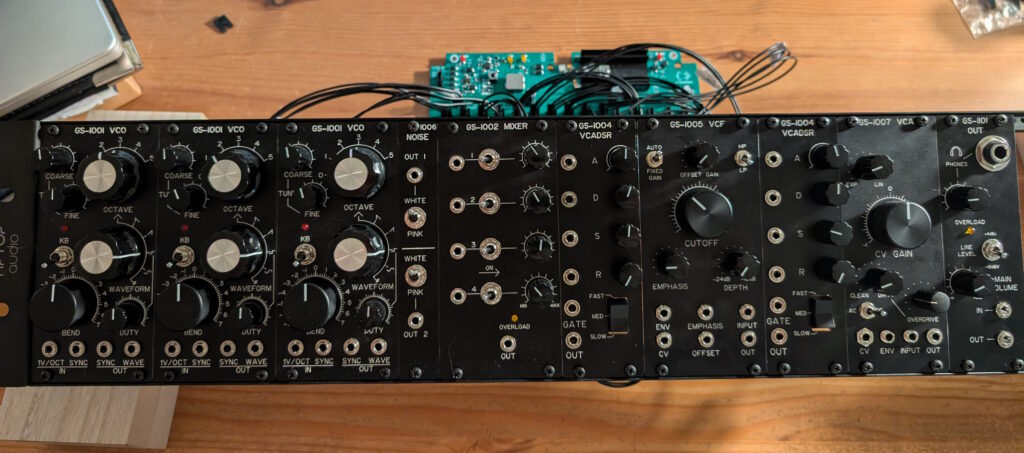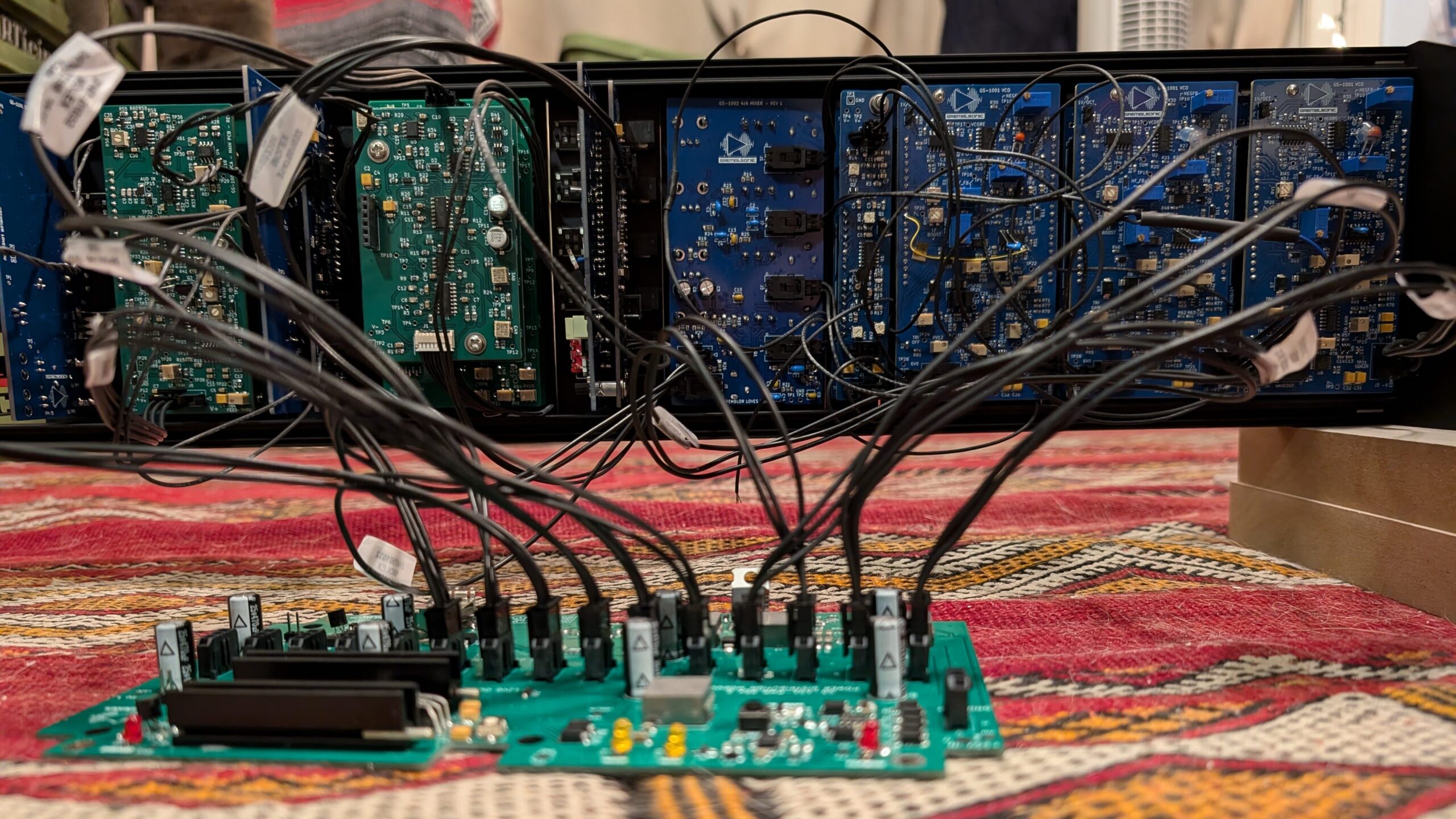Ironically, since I’ve spent so much time working on this project, I have not posted about it much—but I’ve spent a huge amount of my free time in the past two years or so building a complete analog synthesizer. From scratch. And now it’s really starting to come together!

In late 2022, I set my sights to build a Minimoog-like* analog synthesizer, which would require assembling several individual components, including oscillators (for sound generation), a tunable filter, tunable amplifier, white noise generator, and various utilities like a mixer, line out, etc., as well as a keyboard with which to control it. The keyboard (and one more utility, the LFO or low-frequency oscillator) remain to be built but at this point the core “voice” from oscillator to output is wired together and working!
* On the Minimoog as inspiration…
I love the sound of analog synthesizers and decided I didn’t just need to have one, I want to design and build one of my own, from the ground up.
The fundamental architecture of the project is heavily influenced by the Minimoog Model D: a monophonic synthesizer with three oscillators, noise generator, a mixer, VCF, and VCA, controlled predominantly by an attached keyboard. Like the Minimoog this would not involve any digital synthesis or sound manipulation, and it does not rely on complex integrated circuits like the CEM3340 VCO, but builds up the effects from lower-level analog components like transistors, op amps, and OTAs.
The comparison only goes so far, however. For example, the VCF is an OTA-driven state variable design (albeit with four-pole cutoff) rather than the classic transistor ladder filter of the Moog. This project was inspired by the Minimoog Model D, but is not intended to be a literal reproduction of the original article.
Early on in the project, a friend convinced me to build this as a set of Eurorack modules, which was a wise idea because in addition to the modularity allowing more flexibility in rewiring or expanding the system, or interconnecting with modules built by others, it has also let me take this project more naturally in stages–and also creates boundaries for the inevitable mistakes that required me to rebuild some subsections (sometimes a couple of times).
I ambitiously called this project the Gremblsonic GS-101 Synthesizer System and enumerated a family of modules that would have a consistent look and feel, as well as be specifically designed to interoperate with one another.

Eurorack has some loose “standards” but things like the response range for the control voltage of, say, a particular VCA, may not exactly line up with the output range of an ADSR envelope generator controlling it (possibly made by a different manufacturer), requiring the user to fiddle with scaling knobs or other settings. By designing a complete system of components to interoperate, I could eliminate some of that friction.
An integrated, semi-modular design
Eurorack is also a fully “modular” system where each individual single-purpose unit (“module”) can be connected to any other module on the rack with patch cables; this allows for endless creativity, but also requires the user to know intimately how each component works, and how non-obvious combinations can be used to achieve a particular desired effect. This requires the musician to not be daunted by a high learning curve. I wanted to build something approachable that my friends can play with.

The solution was to design a semi-modular synth: The GS-101 is fully “modular” in that it is made of a collection of individual single-purpose modules (oscillators, amplifiers, filters, envelope generators…) that can be connected in any sequence by routing patch cables between jacks on the front panels, but there is “mirror-universe” wiring on the rear / inside the synth that sets up a default signal chain: outputs of the oscillators and white/pink noise generator flow to a mixer, which is fed into the VCF, then the VCA, then the output.

The result is that you’ve got plenty of knobs to adjust, and freedom to rewire or work in additional effects modules, but you can also just sit down at the keyboard and play it like a piano. (Well, once I get the keyboard controller working, anyway.)
I have worked to truly design and build virtually every module required. While I took inspiration and information from countless academic papers, application notes, and DIY synth blogs and web sites, the final working circuits are all my own. (For better or worse!) Over time I hope to clean up some of my circuit schematics and share more of the details of each module, there are a lot of fun and unique aspects to poke around in.
GS-101 Modules
The complete vision for the GS-101 is a collection of modules and a 3-octave keyboard that will integrate in a single desktop instrument / cabinet, 64 cm wide:
- GS-101-PWR: 48W, ±12V linear DC/DC power supply (requires external 15V, 4A Meanwell AC/DC supply)
- GS-1001: Voltage controlled oscillator (VCO)
- GS-1002: Four channel mixer
- GS-1003: Dual low-frequency oscillator (LFO) [planned]
- GS-1004: Voltage controlled envelope generator (VC-ADSR)
- GS-1005: Voltage controlled multi-mode LP/HP four pole filter (VCF)
- GS-1006: Dual white/pink noise generator
- GS-1007: Voltage controlled amplifier (VCA)
- GS-1101: Output module (headphone amplifier and line out)
- GS-101-KB: Keyboard controller for Fatar keybed [planned]
There are a number of additional modules for the GS-101 expanded system I hope to add later (440 Hz tuner; mults; utilities to sum/scale/offset signals; delay/chorus…) but after spending close to two years getting to this point, I’m trying to not let my TODO list run too far into the next presidential administration just yet.
So far this has been a blast. I’ve learned a ton about electronics and audio, built some simple tools and a much more complex one to help with the hardware engineering process, designed some reusable circuit elements, and at some point got very carried away and coded my own BOM and parts management SaaS database. (Because my Excel sheets were getting seriously out of hand, and the obvious solution is to spend several months chipping away at a React / Flask web app to automate the bookkeeping…) At some point in all of this, my side projects have sprouted several other side projects. I am blessed to live with a very patient and somewhat bemused wife who both encourages my hobbies and seriously loves the Talking Heads.
Watch this space for further news on how the project comes together, as well as closer looks at some of the modules and their design.
